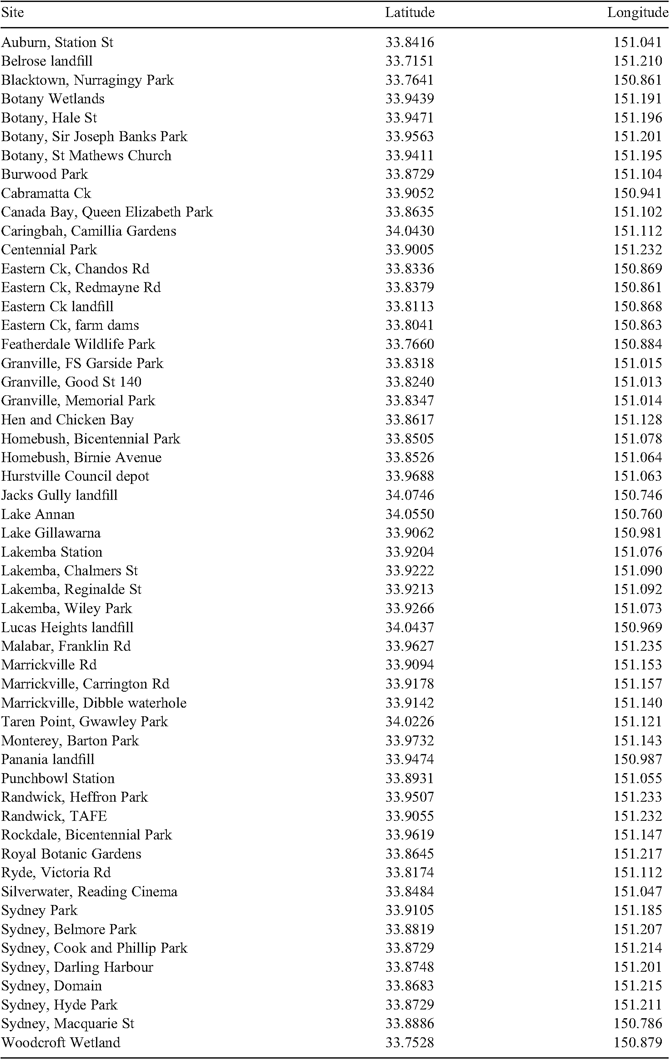Population and breeding trends of an urban coloniser: the Australian white ibis
John Martin A B C , Kris French A and Richard Major BA Institute for Conservation Biology and Law, School of Biological Sciences, University of Wollongong, Wollongong, NSW 2522, Australia.
B Australian Museum, 6 College Street, Sydney, NSW 2010, Australia.
C Corresponding author. Email: jmm84@uow.edu.au
Wildlife Research 37(3) 230-239 https://doi.org/10.1071/WR10047
Submitted: 8 March 2010 Accepted: 24 March 2010 Published: 18 May 2010
Abstract
Context. In the Sydney region, the population of Australian white ibis has dramatically increased from rare observations in the 1950s to a breeding season peak of 8900 in 2008, resulting with human–wildlife conflicts. Within natural habitats across the eastern states, the ibis population has declined, yet within urban environments ibis have been lethally managed for over 30 years. However, limited ecological and no regional population data are available for the Sydney region.
Aims. The present study of ibis in the Sydney region aims to (1) establish the abundance of the population during the breeding and non-breeding seasons, (2) determine whether the population is increasing, and (3) identify the importance of different foraging and roosting sites.
Methods. Across the Sydney region, we surveyed 54 discrete sites for 2.5 years. At each site, we recorded the number of adult, juvenile and nestling ibis as well as the number of active nests. The 54 sites were grouped into 15 areas consisting of five landfills and 10 suburbs, which were assessed with ANOVA.
Key results. The ibis population of the Sydney region doubled from a peak of 4200 in 2006 to 8900 in 2008. Seasonal fluctuations saw adults migrating in to the region to breed, and adults and juveniles dispersing following breeding. On average, 44% of the population was located foraging within landfills, whereas 80% of nesting activity occurred within ‘urban-natural’ habitats.
Conclusions. Seasonal fluctuations indicated that the ibis population of Sydney is connected with the broader state and national population. Landfills provided an abundant foraging resource that supported extended breeding, including consistent nesting for a 19-month period.
Implications. The present study indicated that any localised population management has consequences beyond the immediate or regional population and, consequently, regional management plans or actions need to consider the long-term status of the eastern states’ population. Urban conflicts need to be resolved with human education and a conservation agenda, preferably with the provision of refuge habitat where birds are not disturbed.
Acknowledgements
We thank the W. V. Scott Charitable Trust, the New South Wales (NSW) Department of Environment, Climate Change and Water (DECCW) and the Australian Museum for financial support. Thanks go to Geoff Ross and Cici Legoe of DECCW, Judy White of Waste Services NSW, Helene Forsyth of Bankstown Council and Judy Harrington of SOPA for assistance. Thanks go also to the anonymous reviewers for their constructive comments. This research was conducted in accordance with the University of Wollongong Animal Care and Ethics Committee (AE05-15r8) and NPWS Scientific Licence (S12568).
Adams, L. W. (2005). Urban wildlife ecology and conservation: a brief history of the discipline. Urban Ecosystems 8, 139–156.
| Crossref | GoogleScholarGoogle Scholar |
Belant, J. L. (1997). Gulls in urban environments: landscape-level management to reduce conflicts. Landscape and Urban Planning 38, 245–258.
| Crossref | GoogleScholarGoogle Scholar |
Dixon, J. , and McGill, A. (1979). Sydney district spring bird count (November). NSW Field Ornithologists Club Newsletter 42(Suppl.), 1–6.
Frederiksen, M. , Lebreton, J. D. , and Bregnballe, T. (2001). The interplay between culling and density-dependence in the great cormorant: a modelling approach. Journal of Applied Ecology 38, 617–627.
| Crossref | GoogleScholarGoogle Scholar |
Leach, G. J. (1994). Effects of dam size on waterbirds at farm dams in south-east Queensland. Corella 18, 77–82.
Martin, J. M. , French, K. , and Major, R. E. (2007). The pest status of Australian white ibis (Threskiornis molucca) in urban situations and the effectiveness of egg-oil in reproductive control. Wildlife Research 34, 319–324.
| Crossref | GoogleScholarGoogle Scholar |
Ramos, R. , Ramírez, F. , Sanpera, C. , Jover, L. , and Ruiz, X. (2009). Diet of yellow-legged Gull (Larus michahellis) chicks along the Spanish western Mediterranean coast: the relevance of refuse dumps. Journal fur Ornithologie 150, 265–272.
| Crossref | GoogleScholarGoogle Scholar |
Savard, J. L. , Clergeau, P. , and Mennechez, G. (2000). Biodiversity concepts and urban ecosystems. Landscape and Urban Planning 48, 131–142.
| Crossref | GoogleScholarGoogle Scholar |
Skórka, P. , Wójcik, J. D. , and Martyka, R. (2005). Colonization and population growth of Yellow-legged Gull Larus cachinnans in south eastern Poland: causes and influence on native species. The Ibis 147, 471–482.
| Crossref | GoogleScholarGoogle Scholar |
Smith, G. C. , and Carlile, N. (1993). Food and feeding ecology of breeding silver gulls (Larus novaehollandiae) in Urban Australia. Colonial Waterbirds 16, 9–16.
| Crossref | GoogleScholarGoogle Scholar |

Svensson, E. (1995). Avian reproductive timing: when should parents be prudent? Animal Behaviour 49, 1569–1575.
| Crossref | GoogleScholarGoogle Scholar |

Thomas, G. J. (1972). A review of gull damage and management methods at nature reserves. Biological Conservation 4, 117–127.
| Crossref | GoogleScholarGoogle Scholar |

Walker, K. F. (1985). A review of the ecological effects of river regulation in Australia. Hydrobiologia 125, 111–129.
| Crossref | GoogleScholarGoogle Scholar |

Williams, A. J. , and Ward, V. L. (2006). Sacred ibis and grey heron predation of cape cormorant eggs and chicks; and a review of Ciconiiform birds as seabird predators. Waterbirds 29, 321–327.
| Crossref | GoogleScholarGoogle Scholar |


|


